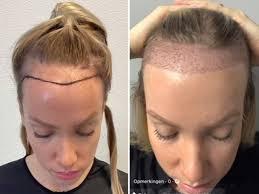
Hair loss can be a distressing experience for anyone, regardless of gender. Female hair loss, in particular, can be emotionally challenging, affecting self-esteem and confidence. However, modern medical advancements have provided a solution in the form of https://www.royalclinicsaudia.com/en-sa/hair-transplant/female-hair-tran.... This step-by-step guide will walk you through the process of female hair transplantation, providing insights into its benefits, considerations, and aftercare.
Understanding Female Hair Loss
Hair loss in women can result from a variety of factors, including genetics, hormonal changes, medical conditions, and even certain hairstyles. While remedies like medications, topical treatments, and lifestyle changes can help to some extent, female hair transplants offer a more permanent solution for those seeking a fuller head of hair.
Female Hair Transplant: An Overview
A female hair transplant is a surgical procedure that involves the transplantation of hair follicles from the donor area (usually the back or sides of the scalp) to the recipient area with thinning or no hair. This procedure is meticulously performed under the supervision of trained surgeons and medical professionals.
Preparing for the Procedure
Before the procedure, you will have an initial consultation with the surgeon. They will evaluate your hair loss pattern, donor area quality, and discuss your goals. You may need to adjust your medications, avoid blood-thinning substances, and refrain from alcohol in the days leading up to the surgery.
Step-by-Step Guide to Female Hair Transplant
Consultation and Evaluation: A comprehensive evaluation of your hair loss, scalp condition, and medical history takes place. This helps the surgeon determine the most suitable approach.
Donor Area Preparation: The donor area is trimmed, ensuring optimal graft harvesting. This area is chosen due to its resistant hair follicles that are less prone to hormonal influence.
Anesthesia Administration: Local anesthesia is administered to the donor and recipient areas to ensure a painless procedure.
Follicle Extraction: Follicular units are carefully extracted using techniques like FUE (Follicular Unit Extraction) or FUT (Follicular Unit Transplantation).
Recipient Site Creation: Tiny incisions are made in the recipient area where the transplanted follicles will be placed.
Graft Placement: The extracted follicles are meticulously placed in the recipient sites following a natural hair growth pattern.
Post-Transplant Care Instructions: The surgeon provides post-operative care guidelines, including washing instructions, medication recommendations, and activity restrictions.
Factors Affecting the Success of Female Hair Transplant
Age and Hormones: Younger women with stable hair loss patterns tend to have better outcomes. Hormonal imbalances can impact the success of the procedure.
Donor Area Suitability: The quality and density of the donor area play a crucial role in achieving a natural-looking result.
Health and Lifestyle Factors: Overall health, nutrition, and lifestyle choices can influence the healing process and final results.
Benefits of Female Hair Transplant
Permanent Solution: Transplanted hair follicles are resistant to hormonal factors, offering a long-lasting solution.
Natural Appearance: The transplanted hair blends seamlessly with existing hair, providing a natural look.
Boosted Confidence: Restoring a fuller head of hair can significantly improve self-esteem and confidence.
Addressing Concerns and FAQs
Is the procedure painful?
The procedure is performed under local anesthesia, minimizing discomfort.
How long is the recovery period?
Most patients can resume normal activities within a week, with complete recovery in a few months.
Are the results immediate?
The transplanted hair will shed initially but will regrow within a few months, gradually achieving full results.
Are there any risks involved?
Like any surgical procedure, there are minimal risks such as infection or scarring, but these are rare and can be managed.
Can I style my transplanted hair?
Yes, once the transplanted hair has fully grown, you can style it just like your natural hair.
Conclusion
Female hair transplant offers a viable solution for women struggling with hair loss. By following this step-by-step guide, you've gained insights into the procedure, benefits, and considerations. The journey to regaining confidence and a fuller head of hair begins with a consultation and ends with a transformed appearance.

Comments
DavidGoata
08 / 15 / 23
Permalink
ksiethel
[url=https://atenolola.charity/]atenolol[/url]
Darrylpat
08 / 15 / 23
Permalink
xcwvrdov
[url=http://prednisolone.solutions/]prednisolone 20mg[/url]
Curtisvep
08 / 15 / 23
Permalink
atojznkx
[url=https://promethazine.foundation/]phenergan 10mg australia[/url]
Charlesfip
08 / 15 / 23
Permalink
top rated online canadian pharmacies 377 mg
Hi there! [url=https://onlinexpspharmacy.top/#online-pharmacy-school]highest rated canadian pharmacies[/url] good site.
[url=https://onlinexpspharmacy.top/#]mzy[/url]
BrettOceax
08 / 15 / 23
Permalink
Lateitendaden zqrak
dark market how to get on darknet market [url=https://darkwebmarketlinksus.com/ ]buying drugs on darknet reddit [/url]
SamuelLique
08 / 15 / 23
Permalink
bdmeoqvi
[url=https://metformin.party/]glucophage tablet 250 mg[/url]
Marystilt
08 / 15 / 23
Permalink
luaypdbhc
[url=https://lipitor.charity/]generic lipitor[/url]
Williamrip
08 / 15 / 23
Permalink
djdatfjx
[url=https://promethazine.foundation/]phenergan 10mg[/url]
SamuelLique
08 / 15 / 23
Permalink
apbgxmqf
[url=https://hydroxyzine.science/]atarax 25mg prescription[/url]
Alanstilt
08 / 15 / 23
Permalink
hwgkwznklt
[url=https://robaxin.party/]robaxin otc uk[/url]